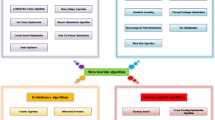Abstract
Optimal operation of cascade hydropower reservoirs is a complex high-dimensional engineering problem. Developing an appropriate model to solve such problems requires an efficient search method proportional to the dimensions of the problem. Accordingly, this research employed the new fitness-distance-balance (FDB) selection method in the moth swarm algorithm (MSA) to achieve promoted FDB-MSA with a high performance in solving complex large-scale problems. To ensure the efficiency of the developed algorithm, five benchmark functions of Shekel, Six-Hump Camel, McCormick, Goldstein-Price and Rosenbrock were used. Then, the FDB-MSA was used for optimization of hydropower generation of a real five-reservoir system along Karun River at Iran. This is the largest cascade reservoir system in Iran, which supplies more than 90% of the country’s hydropower demand. The results of the developed algorithm were compared with those of genetic algorithm (GA) and particle swarm optimization (PSO) algorithm. It was found that the FDB-MSA could successfully increase the hydropower generation by 59.5% (6724 GW) compared to the actual generation of energy over a 180-months operational period. The corresponding values for PSO and GA algorithms were 54.3% and 9.2% respectively. In addition, the results revealed the superiority of FDB-MSA to GA and PSO, so that, it demonstrated the smallest difference (3.41%) between nominal and optimal power generation compared to the PSO (6.58%) and GA (33.89%).






Similar content being viewed by others
Data Availability
All data, models, or code generated or used during the study are available from the corresponding author by request.
References
Akbarifard S, Sharifi MR, Qaderi K (2020) Data on optimization of the karun-4 hydropower reservoir operation using evolutionary algorithms. Data Brief 29:105048
Azizipour M, Ghalenoei V, Afshar MH, Solis SS (2016) Optimal operation of hydropower reservoir systems using weed optimization algorithm. Water Resour Manag 30(11):3995–4009
Barros MT, Tsai FT, Yang SL, Lopes JE, Yeh WW (2003) Optimization of large-scale hydropower system operations. J Water Resour Plan Manag 129(3):178–188
Dahmani S, Yebdri D (2020) Hybrid algorithm of particle swarm optimization and Grey Wolf optimizer for reservoir operation management. Water Resour Manag 34:4545–4560
Dezab Consulting Engineering CO (2010) Systematic studies report on Dez and Karun basin. Water resources planning studies. Ministry of Energy of Iran. First edition
Ehteram, M., Binti Koting, S., Afan, H. A., Mohd, N. S., Malek, M. A., Ahmed, A. N., ... & El-Shafie, A. (2019). New evolutionary algorithm for optimizing hydropower generation considering multireservoir systems. Appl Sci 9(11): 2280
Jevtic M, Jovanovic N, Radosavljevic J, Klimenta D (2017) Moth swarm algorithm for solving combined economic and emission dispatch problem. Elektronika ir Elektrotechnika 23(5):21–28
Kahraman HT, Aras S, Gedikli E (2020) Fitness-distance balance (FDB): a new selection method for meta-heuristic search algorithms. Knowl-Based Syst 190:105169
Luque-Chang A, Cuevas E, Pérez-Cisneros M, Fausto F, Valdivia-González A, Sarkar R (2020) Moth swarm algorithm for image contrast enhancement. Knowl-Based Syst 212:106607
Madadi MR, Akbarifard S, Qaderi K (2020) Performance evaluation of improved symbiotic organism search algorithm for estimation of solute transport in Rivers. Water Resour Manag 34:1453–1464
Mantegna RN (1994) Fast, accurate algorithm for numerical simulation of levy stable stochastic processes. Phys Rev E 49(5):4677–4683
Mcfadyen A, Corke P, Mejias L (2014) Visual predictive control of spiral motion. IEEE Trans Robot 30(6):1441–1454
Mirjalili S (2015) Moth-flame optimization algorithm: a novel nature-inspired heuristic paradigm. Knowl-Based Syst 89:228–249
Mohamed AAA, Mohamed YS, El-Gaafary AA, Hemeida AM (2017) Optimal power flow using moth swarm algorithm. Electr Power Syst Res 142:190–206
Mohammed AA, Sule BF, Salami AW, Adeogun AG (2019) Optimization of energy generation based on operations and ecological integrity requirements. Slovak J Civil Eng 27(3):55–62
Nair SJ, Sasikumar K (2019) Fuzzy reliability-based optimization of a hydropower reservoir. J Hydroinf 21(2):308–317
Séguin S, Audet C, Côté P (2017) Scenario-tree modeling for stochastic short-term hydropower operations planning. J Water Resour Plan Manag 143(12):04017073
Shen J, Cheng C, Wang S, Yuan X, Sun L, Zhang J (2020) Multi-objective optimal operations for an interprovincial hydropower system considering peak-shaving demands. Renew Sust Energ Rev 120:109617
Wu X, Cheng C, Lund JR, Niu W, Miao S (2018) Stochastic dynamic programming for hydropower reservoir operations with multiple local optima. J Hydrol 564:712–722
Yucesan M, Kahraman G (2019) Risk evaluation and prevention in hydropower plant operations: a model based on Pythagorean fuzzy AHP. Energy Policy 126:343–351
Zhang J, Wu Z, Cheng CT, Zhang SQ (2011) Improved particle swarm optimization algorithm for multi-reservoir system operation. Water Sci Eng 4(1):61–73
Zhou J, Jia B, Chen X, Qin H, He Z, Liu G (2019) Identifying efficient operating rules for hydropower reservoirs using system dynamics approach—a case study of three gorges reservoir, China. Water 11(12):2448
Zhou Y, Yang X, Ling Y, Zhang J (2018) Meta-heuristic moth swarm algorithm for multilevel thresholding image segmentation. Multimed Tools Appl 77(18):23699–23727
Acknowledgements
We are grateful to the Research Council of Shahid Chamran University of Ahvaz for financial support (GN: SCU.WH99.26878). Also, we acknowledge the Khuzestan Water and Power Authority.
Funding
No funding was received to assist with the preparation of this manuscript.
Author information
Authors and Affiliations
Contributions
Saeid Akbarifard: Methodology, Writing, Original draft preparation, Data analysis. Mohamad Reza Sharifi: Conceptualization, Data collection, Supervision. Kourosh Qaderi: Visualization, Review, Supervision. Mohamad Reza Madadi: Review, English editing, Revision preparation.
Corresponding author
Ethics declarations
Consent for Publication
the authors declare their consent to publication of this manuscript by “Water Resources Management” journal.
Consent to Participate
The authors declare their consent to participate in this work.
Conflict of Interest
The authors declared that they have no conflicts of interest to this work.
Additional information
Publisher’s Note
Springer Nature remains neutral with regard to jurisdictional claims in published maps and institutional affiliations.
Rights and permissions
About this article
Cite this article
Sharifi, M.R., Akbarifard, S., Qaderi, K. et al. Developing MSA Algorithm by New Fitness-Distance-Balance Selection Method to Optimize Cascade Hydropower Reservoirs Operation. Water Resour Manage 35, 385–406 (2021). https://doi.org/10.1007/s11269-020-02745-8
Received:
Accepted:
Published:
Issue Date:
DOI: https://doi.org/10.1007/s11269-020-02745-8




